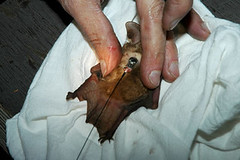
Once we caught the bats, we put them into cloth bags for safekeeping (and to collect guano samples, if they'd been out feeding already.) The bags went into my pockets to stay toasty warm. Then we brought them out one at a time for processing, which consisted of weighing them, measuring arm length, determining reproductive status, putting on a band, and finally applying a radio transmitter. The transmitters are tiny, with a fairly long flexible antenna. We trimmed the fur off a small part of the bat's back and then glued the radio transmitter to the bat using eyelash adhesive. This photo shows a bat with transmitter attached, waiting for the adhesive to dry. Incidentally, if you notice some blood on the thumb which is gently holding the bat, it's from a feisty bat biting the human hand, not from any wound on the bat. Batgrrl says, never handle a bat if you haven't had your full rabies shots!
The transmitters emit a pulse at a specific frequency, which we pick up using directional antennas and a receiver. From the pulse rate we can calculate the bat's body temperature, and thus know if it's active, or in torpor. The batteries on the transmitters only last a couple of weeks, so we have to move quickly to collect the data. Also, bats are avid groomers, and often will clean the transmitters off before the batteries run out. So it's a bit of a guessing game to figure out if the bat is asleep, or if it's just a dropped transmitter.
Now that we've got some bats tagged, we will transform into detectives, to find out where they are roosting and foraging.
Photo by Bill Hepburn.
 Once we caught the bats, we put them into cloth bags for safekeeping (and to collect guano samples, if they'd been out feeding already.) The bags went into my pockets to stay toasty warm. Then we brought them out one at a time for processing, which consisted of weighing them, measuring arm length, determining reproductive status, putting on a band, and finally applying a radio transmitter. The transmitters are tiny, with a fairly long flexible antenna. We trimmed the fur off a small part of the bat's back and then glued the radio transmitter to the bat using eyelash adhesive. This photo shows a bat with transmitter attached, waiting for the adhesive to dry. Incidentally, if you notice some blood on the thumb which is gently holding the bat, it's from a feisty bat biting the human hand, not from any wound on the bat. Batgrrl says, never handle a bat if you haven't had your full rabies shots!
The transmitters emit a pulse at a specific frequency, which we pick up using directional antennas and a receiver. From the pulse rate we can calculate the bat's body temperature, and thus know if it's active, or in torpor. The batteries on the transmitters only last a couple of weeks, so we have to move quickly to collect the data. Also, bats are avid groomers, and often will clean the transmitters off before the batteries run out. So it's a bit of a guessing game to figure out if the bat is asleep, or if it's just a dropped transmitter.
Now that we've got some bats tagged, we will transform into detectives, to find out where they are roosting and foraging.
Photo by Bill Hepburn.
Once we caught the bats, we put them into cloth bags for safekeeping (and to collect guano samples, if they'd been out feeding already.) The bags went into my pockets to stay toasty warm. Then we brought them out one at a time for processing, which consisted of weighing them, measuring arm length, determining reproductive status, putting on a band, and finally applying a radio transmitter. The transmitters are tiny, with a fairly long flexible antenna. We trimmed the fur off a small part of the bat's back and then glued the radio transmitter to the bat using eyelash adhesive. This photo shows a bat with transmitter attached, waiting for the adhesive to dry. Incidentally, if you notice some blood on the thumb which is gently holding the bat, it's from a feisty bat biting the human hand, not from any wound on the bat. Batgrrl says, never handle a bat if you haven't had your full rabies shots!
The transmitters emit a pulse at a specific frequency, which we pick up using directional antennas and a receiver. From the pulse rate we can calculate the bat's body temperature, and thus know if it's active, or in torpor. The batteries on the transmitters only last a couple of weeks, so we have to move quickly to collect the data. Also, bats are avid groomers, and often will clean the transmitters off before the batteries run out. So it's a bit of a guessing game to figure out if the bat is asleep, or if it's just a dropped transmitter.
Now that we've got some bats tagged, we will transform into detectives, to find out where they are roosting and foraging.
Photo by Bill Hepburn.


0 Comments:
Post a Comment
<< Home